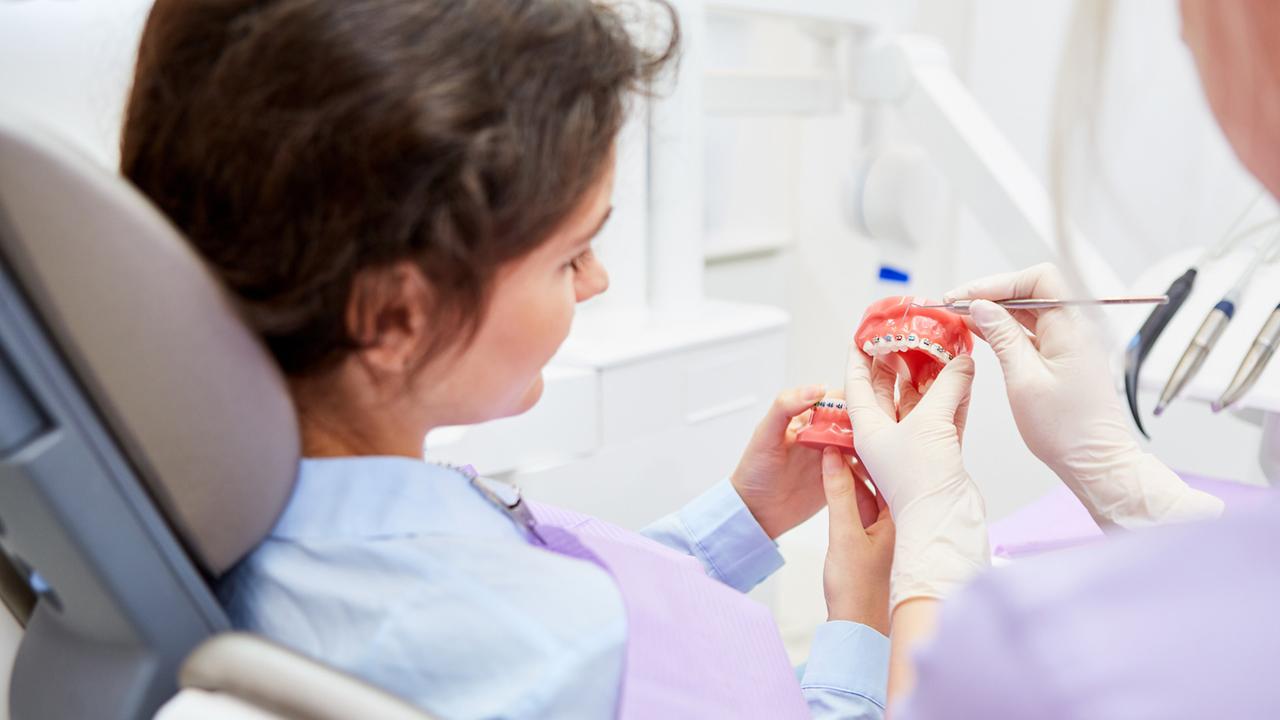exclusive
In Germany, two out of three children get braces. Research by ndr, WDR and Süddeutsche Zeitung are now revealing the profit opportunities in the industry. There is also criticism from orthodontists.
If you look at international comparisons, you quickly get the impression that German children have the most crooked teeth in the world. While in neighboring Denmark around 29 percent of children get braces, in Sweden 30 percent and in Norway 35 percent, in Germany an estimated 66 percent get braces.
Years ago, the German Health Care Advisory Council stated: “The treatment of young people with orthodontic measures exceeds all international norms by more than 60 percent.”
But the National Association of Statutory Health Insurance Dentists (KZBV) and the German Dental Association (BZÄK) apparently see nothing wrong with this. In 2022, the two professional associations presented the “Sixth Oral Health Study”, which came to an astonishing result. According to it, “for medical reasons, orthodontic treatment (…) could in principle be indicated for a total of 97.5 percent” of children. In other words: Almost every child could need braces.
Criticism of long Treatment time
But there is resistance, even among orthodontists themselves. One of those who has been speaking openly about the problem for years is Henning Madsen from Mannheim. Madsen criticizes not only the extraordinarily high number of braces that are prescribed in Germany. The long treatment time is also problematic. On average, treatment in this country takes around 42 months, the KZBV said when asked. Other countries, such as Austria, manage this in a much shorter time.
Critics suspect that the long treatment time could also be due to the way in which billing is done in this country. Orthodontists in Austria have been receiving a flat rate since 2015, which currently amounts to around 4,400 euros. Since the change, the average treatment time in Austria has fallen significantly, to 26 months.
German orthodontists can also bill for individual treatment steps over very long periods of time. The long treatment times in Germany have less of a medical reason, but are “more due to the doctors' desire for a high income,” suspects orthodontist Madsen.
Statutory health insurance companies generally pay for braces
In principle, statutory health insurance companies pay for braces for all children up to the age of 18 – provided that certain misalignments of the teeth are diagnosed. According to information from the KZBV, the insurance companies paid an average of 3,126 euros for braces last year.
But once the parents are in the practice, many orthodontists argue that there are brackets and arches that are not covered by insurance, which can shorten treatment time or make it less painful. Several studies cast doubt on these statements. A meta-analysis in 2021 concluded that “the vast majority” of studies “did not find a single significant difference between the three types of brackets.”
“Great uncertainty in parenthood”
A total of around 80 percent of all parents make private co-payments, according to a report commissioned by the Ministry of Health. “We observe a great deal of uncertainty among parents when it comes to braces,” says Gesa Schölgens from the North Rhine-Westphalia Consumer Advice Center. “Parents do not feel well informed by orthodontists and often feel pressured to accept services that are subject to payment,” says Schölgens, “and unfortunately there is often a profiteering scheme.” From the Consumer Advice Center's point of view, says Schölgens, the health insurance benefits are sufficient.
Natalia and Alexander Z. are an example of this. In November 2022, they visited their orthodontist's office in Berlin. The family has since requested their medical records and they ndr, WDR and Süddeutsche Zeitung. The dentist diagnosed her then twelve-year-old son with misaligned teeth and recommended that the family get braces.
“The dental assistant showed me pictures of brackets that the health insurance company offers,” remembers Natalia Z. “The picture showed very large brackets. And then she offered me the Damon bracket system. She said that these smaller brackets are more comfortable for the children and that the treatment is completed more quickly.” In the end, the Z. family agreed to a private co-payment of 2,430 euros.
Enormous marketing
Damon brackets are very popular and the manufacturer does a lot of marketing to doctors. ndr, WDR and Süddeutsche Zeitung have researched the prices for brackets from various manufacturers and evaluated internal company documents. For example, mini brackets made of stainless steel are available from the company Smiledental for as little as 59 cents each.
Brackets with their own locking mechanism, so-called self-ligating brackets, can be purchased for around three euros. Damon is significantly more expensive in comparison; in the manufacturer's catalog, brackets cost around 25 euros each. In fact, according to internal documents, the company gives orthodontists a 40 percent discount “as standard.”
According to the patient's file, the dentist treating the Z. family charged almost 24 euros per bracket, in addition to the 18 euros paid by the health insurance company. The Berlin orthodontist did not answer any questions, nor did the manufacturer Damon. The German Association of Orthodontists emphasizes that patients are free to opt for treatment without paying any additional costs.
“You earn well anyway”
The orthodontist Alexander Spassov from Greifswald has also long criticized his colleagues' greed for profit. Most children and young people get braces from him at the expense of the health insurance company. “You can earn good money anyway,” says Spassov, referring to a publication by the Institute of German Dentists.
It says that over the years an orthodontist spends five hours and 23 minutes on each braces treatment. “I can do it even faster,” says Spassov, namely in about three hours. Even with the remuneration negotiated between health insurance companies and dentists, you quickly reach an hourly wage of 1,000 euros gross.”
“Between 5,000 and 7,000 euros for their lectures”
Orthodontist Elizabeth Menzel has her practice in Herrsching am Ammersee. Menzel is one of the best-known advertisers for Damon brackets and calls herself a “key opinion leader”. As an “opinion leader” she gives lectures about brackets to other dentists. The Damon manufacturer advertises Menzel on its website.
Menzel explains that she wants to “educate” and has her patients' health in mind. She does not dispute the fact that there are studies that dispute the medical benefits of Damon brackets. Instead, she refers to her years of positive experience. Nevertheless, in a conversation with ndr, WDR and SZ that she receives “between 5,000 and 7,000 euros” every month for her lectures, including from the Damon manufacturer. “But I'm not paid to market the product, I hold courses.”
Klaus Lieb can only shake his head at this. The professor of psychiatry at the Mainz University Hospital has been dealing with conflicts of interest in medicine for years. 5,000 to 7,000 euros a month “is what I would describe as a high fee that creates a conflict of interest,” says Lieb. Especially since patients are not informed about their conflicts of interest on Menzel's practice website. “The risk that such fees could lead to a distortion is high, regardless of which brackets are actually the best,” says Lieb.




